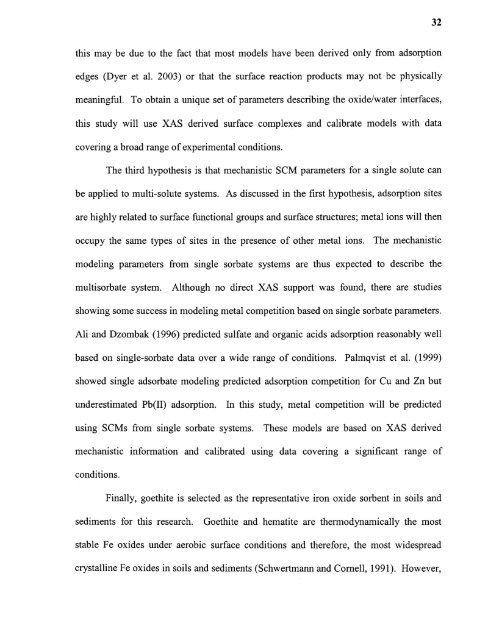Heavy metal adsorption on iron oxide and iron oxide-coated silica ...
Heavy metal adsorption on iron oxide and iron oxide-coated silica ...
Heavy metal adsorption on iron oxide and iron oxide-coated silica ...
Create successful ePaper yourself
Turn your PDF publications into a flip-book with our unique Google optimized e-Paper software.
32this may be due to the fact that most models have been derived <strong>on</strong>ly from <str<strong>on</strong>g>adsorpti<strong>on</strong></str<strong>on</strong>g>edges (Dyer et al. 2003) or that the surface reacti<strong>on</strong> products may not be physicallymeaningful. To obtain a unique set of parameters describing the <strong>oxide</strong>/water interfaces,this study will use XAS derived surface complexes <strong>and</strong> calibrate models with datacovering a broad range of experimental c<strong>on</strong>diti<strong>on</strong>s.The third hypothesis is that mechanistic SCM parameters for a single solute canbe applied to multi-solute systems. As discussed in the first hypothesis, <str<strong>on</strong>g>adsorpti<strong>on</strong></str<strong>on</strong>g> sitesare highly related to surface functi<strong>on</strong>al groups <strong>and</strong> surface structures; <str<strong>on</strong>g>metal</str<strong>on</strong>g> i<strong>on</strong>s will thenoccupy the same types of sites in the presence of other <str<strong>on</strong>g>metal</str<strong>on</strong>g> i<strong>on</strong>s. The mechanisticmodeling parameters from single sorbate systems are thus expected to describe themultisorbate system. Although no direct XAS support was found, there are studiesshowing some success in modeling <str<strong>on</strong>g>metal</str<strong>on</strong>g> competiti<strong>on</strong> based <strong>on</strong> single sorbate parameters.Ali <strong>and</strong> Dzombak (1996) predicted sulfate <strong>and</strong> organic acids <str<strong>on</strong>g>adsorpti<strong>on</strong></str<strong>on</strong>g> reas<strong>on</strong>ably wellbased <strong>on</strong> single-sorbate data over a wide range of c<strong>on</strong>diti<strong>on</strong>s. Palmqvist et al. (1999)showed single adsorbate modeling predicted <str<strong>on</strong>g>adsorpti<strong>on</strong></str<strong>on</strong>g> competiti<strong>on</strong> for Cu <strong>and</strong> Zn butunderestimated Pb(II) <str<strong>on</strong>g>adsorpti<strong>on</strong></str<strong>on</strong>g>. In this study, <str<strong>on</strong>g>metal</str<strong>on</strong>g> competiti<strong>on</strong> will be predictedusing SCMs from single sorbate systems. These models are based <strong>on</strong> XAS derivedmechanistic informati<strong>on</strong> <strong>and</strong> calibrated using data covering a significant range ofc<strong>on</strong>diti<strong>on</strong>s.Finally, goethite is selected as the representative ir<strong>on</strong> <strong>oxide</strong> sorbent in soils <strong>and</strong>sediments for this research. Goethite <strong>and</strong> hematite are thermodynamically the moststable Fe <strong>oxide</strong>s under aerobic surface c<strong>on</strong>diti<strong>on</strong>s <strong>and</strong> therefore, the most widespreadcrystalline Fe <strong>oxide</strong>s in soils <strong>and</strong> sediments (Schwertmann <strong>and</strong> Cornell, 1991). However,
















